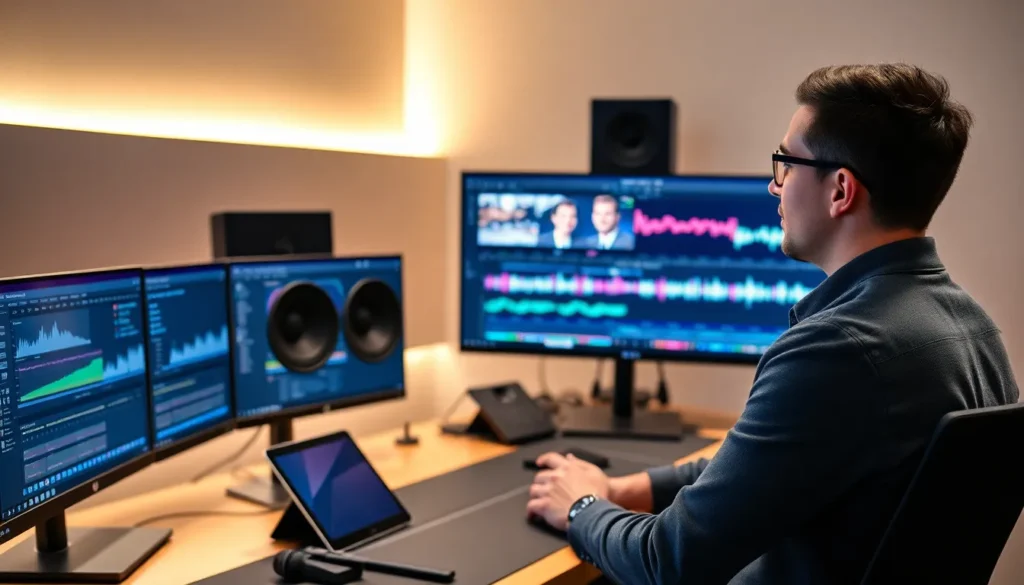Table of Contents
ToggleEver wondered how movies like “Avatar” or series like “Game of Thrones” pull off those jaw-dropping effects? Spoiler alert: it isn’t magic, it’s Avid editing software. This powerful tool is the secret sauce used by professionals in the film and television industry. If you’re looking to elevate your editing game, you’re in for a treat. Grab your popcorn: this guide is going to be a blockbuster.
What Is Avid Editing Software?

Avid editing software is a suite of professional-grade tools designed for video and audio editing, primarily used in the film, television, and music industries. It includes products like Avid Media Composer and Avid Pro Tools, which help experts organize, edit, and finalize content efficiently. Avid’s software stands out for its ability to seamlessly handle complex projects, making it a favorite among editors who juggle multiple media formats and large video files. The software’s reputation for stability and a range of professional features has turned it into the industry standard, letting editors focus on creativity without worrying about technical complications.
Key Features of Avid Editing Software
Avid editing software boasts an array of features that enhance the editing experience. Here are some key highlights:
- Multi-format support: It can handle a broad range of formats, whether it’s 4K video or high-definition audio. This flexibility is a game-changer for modern workflows.
- Advanced editing tools: From precision trimming to multi-camera editing, Avid offers intuitive tools that cater to various editing styles. Users can easily stack clips, add transitions, and create detailed timelines.
- Collaboration capabilities: Avid excels in team environments, allowing multiple users to work on a project simultaneously. The software manages versions efficiently, ensuring everyone is on the same page.
- Robust media management: With features like metadata tagging and bin organization, users can maintain order in vast libraries of media, saving time and mental energy during production.
- Real-time playback: Avid’s system supports real-time effects and playback, offering editors instant visualization of their work, crucial in the fast-paced editing world.
Types of Avid Editing Software
Avid offers a range of products tailored for different needs:
- Avid Media Composer: The flagship product designed for film and television editing. This software is equipped with powerful tools for everything from basic edits to complex visual effects.
- Avid Pro Tools: Mainly focused on audio editing, Pro Tools is an industry standard for sound designers and mixers. It complements Media Composer, creating a robust environment for multimedia projects.
- Avid MediaCentral: This is an integrated media platform that allows editors to manage content from anywhere, making it ideal for remote workflows and collaboration.
- Avid S6 Control Surface: While not software, this hardware integrates with Avid’s software to offer tactile control over audio mixing and editing, enhancing precision and efficiency.
Benefits of Using Avid Editing Software
Choosing Avid editing software comes with a multitude of advantages:
- Industry standard: Using Avid is a smart choice for professionals aiming to break into the film and television industry. Familiarity with this software can enhance job prospects.
- Exceptional reliability: Avid is known for its stability, especially with large projects. Editors can work efficiently without the constant worry of crashes or glitches.
- Extensive support resources: Avid provides comprehensive documentation and community support, making it easier for newcomers to learn and master the software quickly.
- Integration with other tools: Avid’s software easily integrates with a variety of third-party applications, allowing for enhanced functionality and workflows that suit individual needs.
- Long-term investment: With regular updates and a focus on features that maximize efficiency, investing in Avid software pays off over time.
Getting Started with Avid Editing Software
For newcomers eager to jump into Avid editing software, the journey begins with a few straightforward steps:
- Choose the right version: Depending on your editing needs and budget, select the Avid product that best fits. Avid Media Composer First offers a free version with basic tools suitable for beginners.
- Installation: After acquiring your software, ensure your system meets the necessary requirements for smooth operation. Follow the installation prompts meticulously.
- Familiarize yourself with the interface: Take time to explore the layout, tools, and features. Avid’s interface can be overwhelming at first, but getting comfortable will pay off later.
- Tutorials and resources: Use online tutorials, video lessons, and community forums to gain insights and tips from seasoned editors. A quick YouTube search can lead you to a wealth of learning material.
Tips for Maximizing Your Avid Editing Experience
Maximizing your experience with Avid editing software involves a few practical tips:
- Keyboard shortcuts: Learn and use keyboard shortcuts to speed up your editing workflow dramatically. This simple trick can transform your editing pace.
- Organize your assets: Make it a habit to label and categorize media files clearly. A well-organized project can prevent headaches down the line.
- Explore plug-ins: Don’t shy away from experimenting with third-party plug-ins to extend the software’s functionality. This can elevate your projects to new heights.
- Regular backups: Regularly save your work and back up projects to avoid losing precious edits due to unexpected crashes or errors.
- Stay updated: Keep your software updated to benefit from new features and patches. Avid consistently rolls out updates that can improve both performance and functionality.




